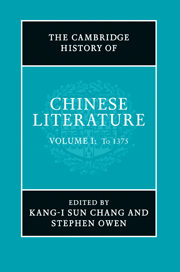Book contents
- Frontmatter
- Introduction
- 1 Early Chinese literature, beginnings through Western Han
- 2 From the Eastern Han through the Western Jin (ad 25–317)
- 3 From the Eastern Jin through the early Tang (317–649)
- 4 The cultural Tang (650–1020)
- 5 The Northern Song (1020–1126)
- 6 North and south: the twelfth and thirteenth centuries
- 7 Literature from the late Jin to the early Ming: ca 1230–ca 1375
- Select bibliography
- Glossary
- Index
- References
1 - Early Chinese literature, beginnings through Western Han
Published online by Cambridge University Press: 28 May 2011
- Frontmatter
- Introduction
- 1 Early Chinese literature, beginnings through Western Han
- 2 From the Eastern Han through the Western Jin (ad 25–317)
- 3 From the Eastern Jin through the early Tang (317–649)
- 4 The cultural Tang (650–1020)
- 5 The Northern Song (1020–1126)
- 6 North and south: the twelfth and thirteenth centuries
- 7 Literature from the late Jin to the early Ming: ca 1230–ca 1375
- Select bibliography
- Glossary
- Index
- References
Summary
The Chinese language and writing system
The earliest evidence for the Chinese language, and for the Chinese script as its writing system, is found in oracle bone and bronze inscriptions from the site of the Late Shang (ca 1250–ca 1046 bc) royal capital near modern Anyang, located in the northernmost part of modern Henan Province. From there to the present day, a continuous line of development can be drawn for both language and script that has served the expression of Chinese literature over the last three millennia. The Chinese script is one of only a handful of instances in human history where writing was invented independently, and it is the only originally invented writing system still in use today. Over time, it was adopted to write not just Chinese but also other East and Southeast Asian languages such as Korean, Japanese, and Vietnamese, thereby extending the reach of the Chinese literary tradition significantly beyond the boundaries of its spoken language.
The Late Shang oracle inscriptions (jiaguwen) scratched into bovine shoulder bones and turtle plastrons were records of communications with the royal ancestral spirits. Since their initial discovery in 1899, more than 150,000 fragments of such inscriptions have been found. They range in length from just a few to several dozen characters and preserve accounts of royal divinations on a wide range of topics – the well-being of the king, military success, the timeliness of sacrifices, the weather, and so on – that affected both the person of the ruler and the prosperity of his state.
- Type
- Chapter
- Information
- The Cambridge History of Chinese Literature , pp. 1 - 115Publisher: Cambridge University PressPrint publication year: 2010
References
- 11
- Cited by

